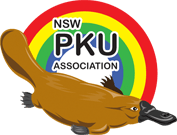Update: January 2010
We had a busy year in 2009, and continue to make steady progress in our PKU research activities.
PKU Gene Studies:
Wecontinue to offer screening of the PKU (phenylalanine hydroxylase; PAH)gene to any of the patients we see in our clinic. PhD student, GladysHo, is performing this work. We anticipate that by identifying thecombination of mistakes (mutations) in the PAH gene, we will be betterable to predict the level of dietary restriction that will be needed. In addition, there are some mutations that allow us to predict thatsome individuals (perhaps up to a third of PKU patients currently ondiet) will be responsive to the essential cofactor, tetrahydrobiopterin(BH4). This is important information, because once BH4 becomes moreeasily available in Australia, we will be in a position to identifythose individuals who are likely to be BH4 responsive for immediateaccess to it.
On that front, we understand that the companytrying to get BH4 approved and licensed in Australia submitted a formalapplication to the Federal agency responsible for reviewing suchapplications in December, and we hope that it will approved in thefirst quarter of this year, although there is no guarantee about thisat present.
So, if you or your PKU child has not had genetictesting done yet and would like this to be done, please discuss thiswith your PKU doctor. The genetic testing is available as part of aresearch project based at the Children’s Hospital at Westmead. We haveinformation sheets and consent forms to become involved in thisresearch, and we are happy to make these available to you through yourPKU doctor.
Progress in the Development of a PAL Probiotic Therapy:
Readerswill recall from previous newsletters that we have been working on anew therapy for PKU, namely the provision of an alternate enzyme,phenylalanine-ammonia lyase (PAL) that is able to break down excessamounts of phenylalanine. A combined research effort in Canada and theUS has developed a chemically modified form of PAL that is delivered topatients by regular injection. Whilst this is a great step forward inthe development of a novel treatment approach to PKU, our view is thatfor many individuals regular injections (it is not clear at this stagehow frequently the injections will need to be given) of the PAL enzymewould not be acceptable.
Our approach is to create agenetically modified (GM) probiotic to produce PAL. This PAL couldthen be delivered through a regular oral drink of a Yakhult type ofpreparation. If it works, phenylalanine released from dietary proteinin the intestine would be broken down before it is even absorbed intothe bloodstream, and this should translate to improved proteintolerance with better control of blood phenylalanine levels.
Withthe generous support of a research grant from the Australian RotaryHealth Fund (sponsored by the Rotary Club of Pennant Hills), andfinancial support from the Rotary Club of Liverpool (Greenaway), wehave been able to develop this idea. We are pleased to report that wenow have working PAL being made by a probiotic called Lactococcus. Weare currently making adjustments to the genetic regulatory machinery sothat we can maximize the efficiency with which PAL is produced by theLactococcus probiotic.
The next step will be to test out our newPKU therapy in a PKU mouse. There is a commercially available mousethat has a severe mutation in the mouse version of the PKU gene, whichin turn results in very high blood phenylalanine levels. There aresignificant costs involved in importing the mouse to Australia,establishing a PKU mouse colony and then performing the trial of the GMLactococcus. Unfortunately, at present we do not have the funds toestablish the mouse colony and perform the therapeutic trial, and so weare currently unable to progress to the next stage. We are currentlyin the process of trying to obtain additional funding from a number ofsources, and if successful in our fundraising activities, we will beable to perform the initial mouse studies over the next 12 months.
We will keep you informed of progress on all these research fronts, so stay tuned for the next installment!
